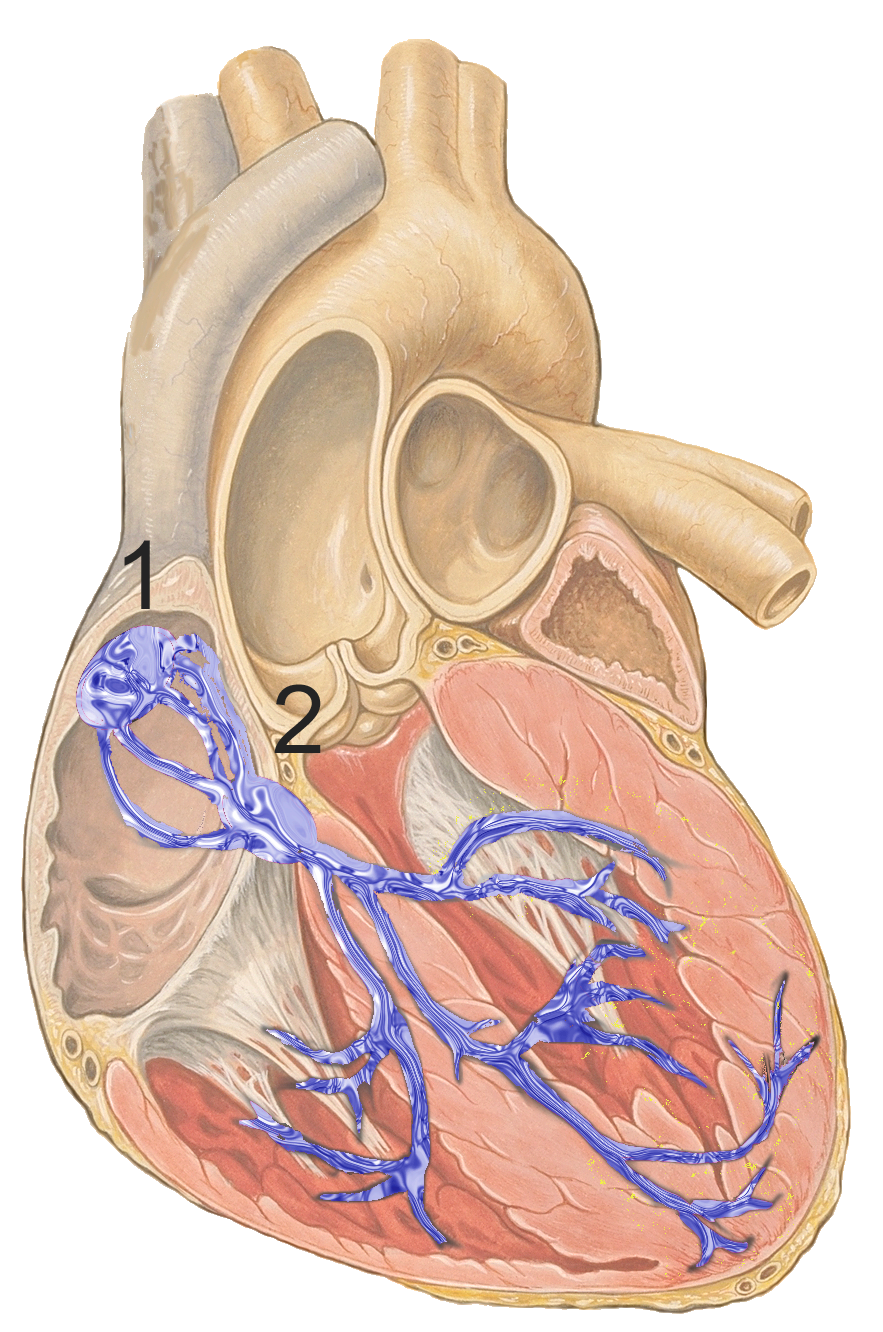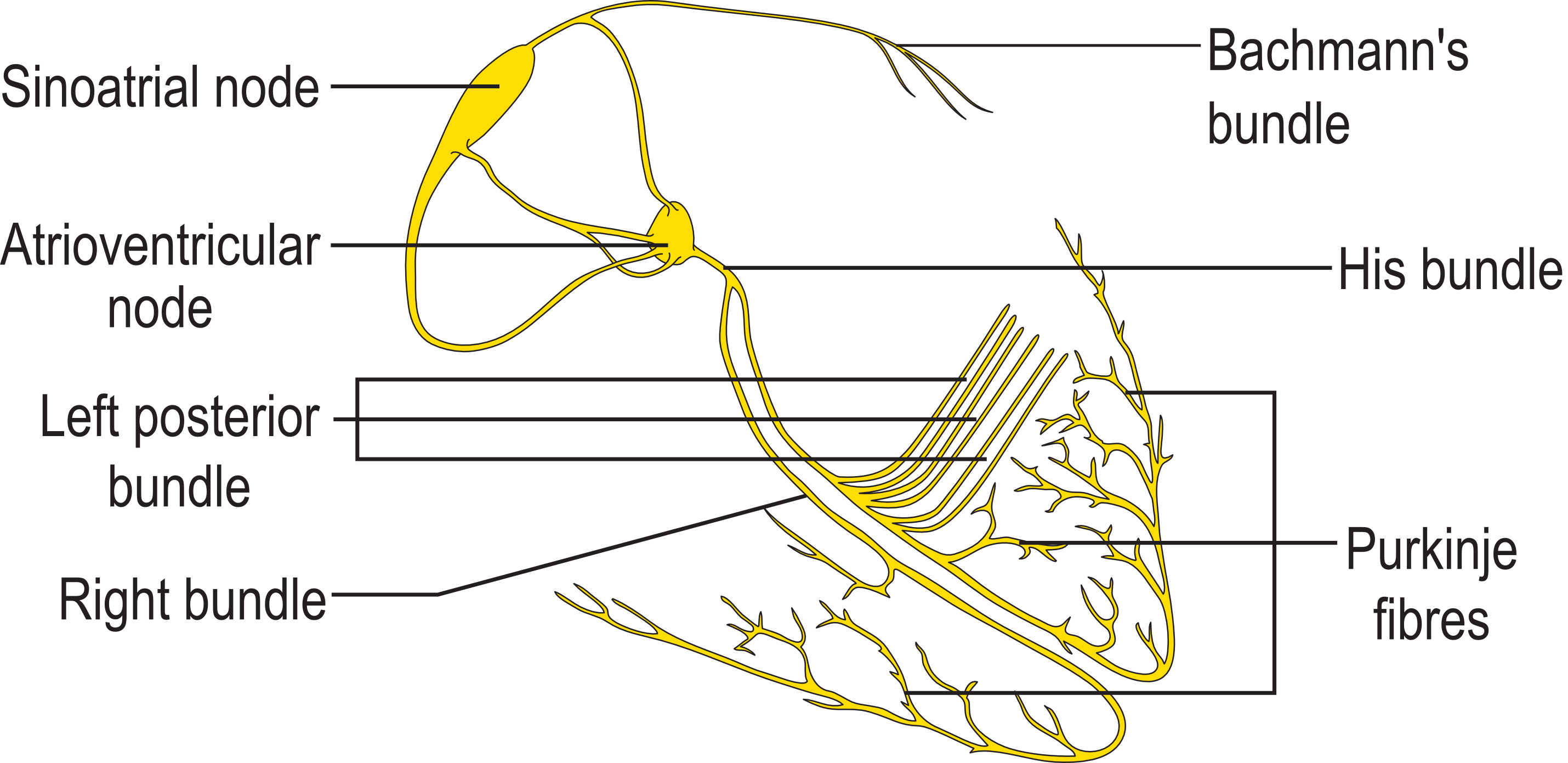Right bundle branch block pathophysiology: Difference between revisions
No edit summary |
No edit summary |
||
| Line 12: | Line 12: | ||
# As the impulse flows through the compact AV node, it rapidly conducts through the ventricular myocardial cells. Once the depolarization is complete, the ventricle relaxes during the diastole in preparation for the next impulse. | # As the impulse flows through the compact AV node, it rapidly conducts through the ventricular myocardial cells. Once the depolarization is complete, the ventricle relaxes during the diastole in preparation for the next impulse. | ||
[[Image:Conduction system of the heart.png|left|thumb|200px|Conduction system of the heart]]<br /><br /><br /><br /><br /><br /><br /><br /><br /><br /><br /><br /><br /><br /><br /><br /><br /><br /> | [[Image:Conduction system of the heart.png|left|thumb|200px|Conduction system of the heart]]<br /><br /><br /><br /><br /><br /><br /><br /><br /><br /><br /><br /><br /><br /><br /><br /><br /><br /><br /> | ||
===Anatomy=== | ===Anatomy=== | ||
Revision as of 16:21, 12 April 2013
|
Right bundle branch block Microchapters |
|
Differentiating Right bundle branch block from other Diseases |
|---|
|
Diagnosis |
|
Treatment |
|
Case Studies |
|
Right bundle branch block pathophysiology On the Web |
|
American Roentgen Ray Society Images of Right bundle branch block pathophysiology |
|
Risk calculators and risk factors for Right bundle branch block pathophysiology |
Editor-In-Chief: C. Michael Gibson, M.S., M.D. [1]; Associate Editor(s)-in-Chief: Cafer Zorkun, M.D., Ph.D. [2], Aarti Narayan, M.B.B.S [3], Raviteja Guddeti, M.B.B.S. [4]
Please help WikiDoc by adding more content here. It's easy! Click here to learn about editing.
Pathophysiology
Normal Conduction
- The normal cardiac conduction proceeds in a way so as to allow time for atrium to relax during atrial diastole.
- The electrical impulse generated in the SA node travels through the internodal pathways towards the AV node.
- The conduction through the AV node is slowed down as it travels through it. This decrease in velocity of conduction allows time for atrial to contract ahead of the ventricle so that the blood from the atria can fill up the ventricles through the atrio-ventricular valves.
- As the impulse flows through the compact AV node, it rapidly conducts through the ventricular myocardial cells. Once the depolarization is complete, the ventricle relaxes during the diastole in preparation for the next impulse.

Anatomy
- The conduction system of the heart consists of specialized cells designed to conduct electrical impulse faster than the surrounding myocardial cells.
- Anatomically, the AV node is divided into three regions as follows:
- Transitional cell zone: This is the region where the internodal atrial pathways merge with the compact AV node.
- Compact AV node: This region is located at the apex of the triangle of Koch, which is formed by the ostium of coronary sinus, tricuspid annulus and the tendon of Todaro.

Three types of RBBB have been identified based upon electrophysiologic studies.
In each of the three types of RBBB, the surface ECG pattern remains the same.
1. Proximal, or central, RBBB: This type of conduction defect occurs when the conduction block is located just distal to the bundle of His in the superior aspect of the right bundle branch. This type of block occurs when the proximal bundle is injured during surgery for an inlet or membranous ventricular septal defect (VSD).
2. Interruption between the proximal and distal aspects of the right bundle branch: This type of right bundle branch block occurs when the impulse is interrupted between the proximal and distal aspects of the right bundle branch. This type of bright bundle branch block is most commonly observed after surgical division of the moderator band.
3. Distal RBBB: This form is observed when distal ramifications of the right bundle are disrupted during right ventriculotomy or resection of muscle bundles in the right ventricular outflow tract.
Genetics
There can be familial cases of right bundle branch block such as that observed in 4 Lebanese families and the abnormality was mapped to chromosome 19. There is a subset of patients with Brugada syndrome who have mutations in SCN5A, the gene encoding for the voltage-gated cardiac sodium channel.
Associated Syndromes
- Duchenne muscular dystrophy
- Myotonic dystrophy: Other ECG findings include first-degree AV block, left anterior fascicular block, and intraventricular conduction delay. Patients may have arrhythmias and/or Stokes-Adams attacks.
- Kearns-Sayre Syndrome
- Brugada syndrome: This syndrome is due to a channelopathy mediated by the SCN5A gene. It is important to note that the RBBB pattern seen in patients with this syndrome is not actually RBBB but is instead due to a repolarization abnormality. In this syndrome, the ECG shows ST-segment elevation in leads V1-V3. Cocaine consumption and / or the use of the antiarrhythmic propafenone may unmask the ECG findings of Brugada syndrome.
Pseudo Right Bundle Branch Block
Brugada syndrome: This syndrome is due to a channelopathy mediated by the SCN5A gene. It is important to note that the RBBB pattern seen in patients with this syndrome is not actually RBBB but is instead due to a repolarization abnormality. It is for this reason that the RBBB like pattern in Brugada syndrome is referred to as a 'pseudo right bundle branch block.' In this syndrome, the ECG shows ST-segment elevation in leads V1-V3. Cocaine consumption and / or the use of the antiarrhythmic propafenone may unmask the ECG findings of Brugada syndrome.